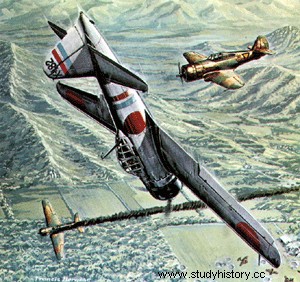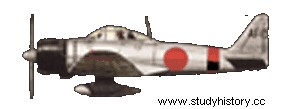Victory
?
Biography

Junichi Sasai won the title of Richthofen from Rabaul despite not took part in the fighting for only a short time. He left the memory, still alive today, of a great leader of the hunt.
Born on February 13, 1918 in Tokyo, the son of a Navy captain, the young Junichi had always been destined to join the armed forces as an officer as soon as he reached the regulatory age. His childhood was marked by poor health which often caused absences from college, where he had to endure the jokes of his classmates. However, a regime of strenuous exercise and diets improved the young man's health. Upon entering junior high school, Junichi found himself physically prepared to earn his black belt in judo; his important achievements in high school facilitated his entry into Etajima.
Sasai graduated from the Academy in 1939 and was appointed ensign. He began flight training, before completing his classes in November 1941; his tenacious spirit earned him the nickname Gamecock. When Japan entered the Pacific War the following month, Sasai had already joined the Tai-Nan Kū. He flew with this group during a raid on Luzon (in the Philippines), on December 10, but had to retire due to engine problems.

After the victory of the Philippines, the T'ai-Nan Kû had considerable activity in the Netherlands Antilles, where it provided air support to ground troops. Sasai's first victory was recorded on February 2, 1942 over Maospati, Java, when he shot down a Dutch Bqffalo. Eighteen days later, he claimed a victory over a P-40E of 17, PS with only 280 machine gun rounds.
The EVI. Sasai received, in April 1942, the command of the 2nd Buntai of T'ai-Nan Kû in whose ranks there were many experienced troop pilots, including SM 1. Saburo Sakai. The latter remained very impressed by his new leader, because, unlike the other officers, he showed sincere compassion for his men. To ensure his survival, Sakai personally instructed the young ensign in the art of dogfighting, and once Sasai improved his shooting, he became an excellent hunter.
On May 4, 1942, he demonstrated his gunnery skills by engaging a patrol of three P-39s, shooting down all three in less than 20 Sasai went on to record multiple victories, reaching his personal best score with five aircraft in one day, the August 7, 1942, over Guadalcanal. This feat was tarnished by the serious injuries of her mentor Saburo Sakai during the same mission and, before the latter was repatriated to Japan, Sasai gave her a personal souvenir:her belt buckle with a tiger, assuring her that she would protect him.
On August 26, Sasai led a formation of nine Betty Bomber escort fighters, whose objective was Henderson Airfield, Guadalcanal. They were intercepted over the target by 12 Wildcats of VMF-223, commanded by Maj John L. Smith and Maj Rivers J. Morrell. Sasai did not return from this mission.
In a letter sent to his family before his death, Sasai credits himself with 54 victories, stating that he had hopes of breaking the record of German World War I ace Baron Manfred von Richthofen (who managed to shoot down 80 planes). According to Naval Proclamation No. 36, Sasai completed 76 war missions with the T'ai-Nan Kū and was credited with 27 victories. He was promoted to the rank of CC., in recognition of his exemplary services.
